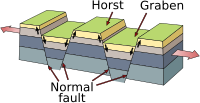Horst and graben

So, imagine you're playing with a big piece of Play-Doh or clay. You push your fingers into it and make a dent. That dent is like a horst. Now, the part that's pushed up around the dent is also called a horst. It's like a big hump.
But what happens if you push your fingers in and pull the clay apart? The clay splits in the middle, right? That split is called a graben. It's like a big crack or a valley.
Well, when we talk about "horst and graben" in geology, we're talking about these kinds of features, but in the Earth's crust. The Earth's crust is like the outer skin of our planet. It's not made of clay, of course, it's made of solid rock. But the same kinds of things can happen to it.
Sometimes, deep under the surface, there's a lot of pressure building up in the rocks. Just like if you push really hard on your clay, it wants to push back or crack open. When that happens, the rocks can break apart and form a big crack or a valley. That's the graben.
But remember, when the rocks break apart, some parts might get pushed up and form a hump. That's the horst. Picture it like squeezing a balloon and having the air going up on one side.
These horst and graben features can be found in places called rift valleys, where the crust is slowly being pulled apart. It's like when you pull on the edges of a piece of tape and it stretches and forms a thin crack in the middle.
One famous example of where you can see horst and graben is the East African Rift, which is a long valley in Africa. It's kind of like a giant zipper that's slowly unzipping the Earth's crust.
So, basically, horst and graben are just fancy names for when the crust of the Earth cracks and forms valleys and humps. It's sort of like what happens when you play with your Play-Doh or clay, but on a much bigger scale!
But what happens if you push your fingers in and pull the clay apart? The clay splits in the middle, right? That split is called a graben. It's like a big crack or a valley.
Well, when we talk about "horst and graben" in geology, we're talking about these kinds of features, but in the Earth's crust. The Earth's crust is like the outer skin of our planet. It's not made of clay, of course, it's made of solid rock. But the same kinds of things can happen to it.
Sometimes, deep under the surface, there's a lot of pressure building up in the rocks. Just like if you push really hard on your clay, it wants to push back or crack open. When that happens, the rocks can break apart and form a big crack or a valley. That's the graben.
But remember, when the rocks break apart, some parts might get pushed up and form a hump. That's the horst. Picture it like squeezing a balloon and having the air going up on one side.
These horst and graben features can be found in places called rift valleys, where the crust is slowly being pulled apart. It's like when you pull on the edges of a piece of tape and it stretches and forms a thin crack in the middle.
One famous example of where you can see horst and graben is the East African Rift, which is a long valley in Africa. It's kind of like a giant zipper that's slowly unzipping the Earth's crust.
So, basically, horst and graben are just fancy names for when the crust of the Earth cracks and forms valleys and humps. It's sort of like what happens when you play with your Play-Doh or clay, but on a much bigger scale!
Related topics others have asked about:
